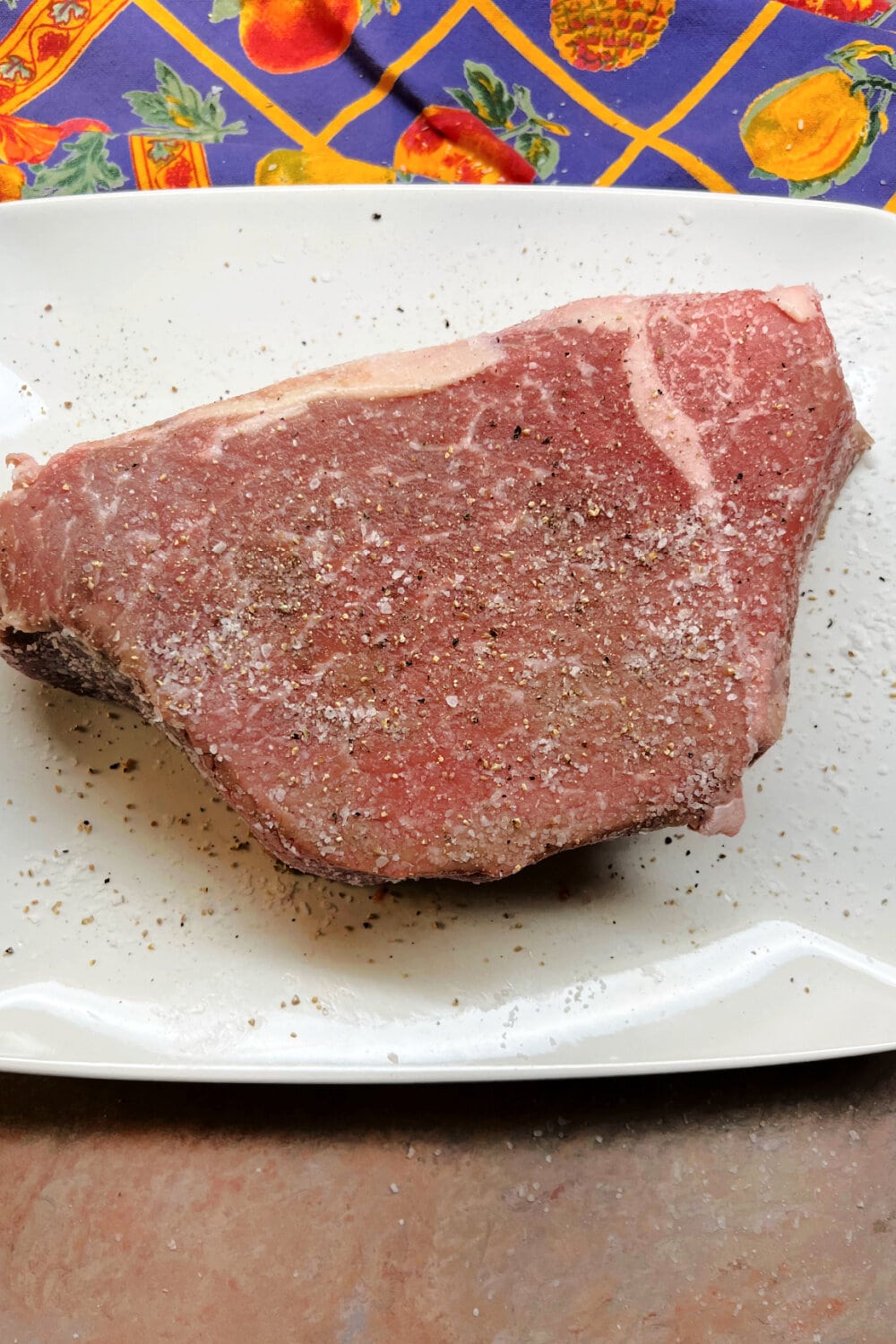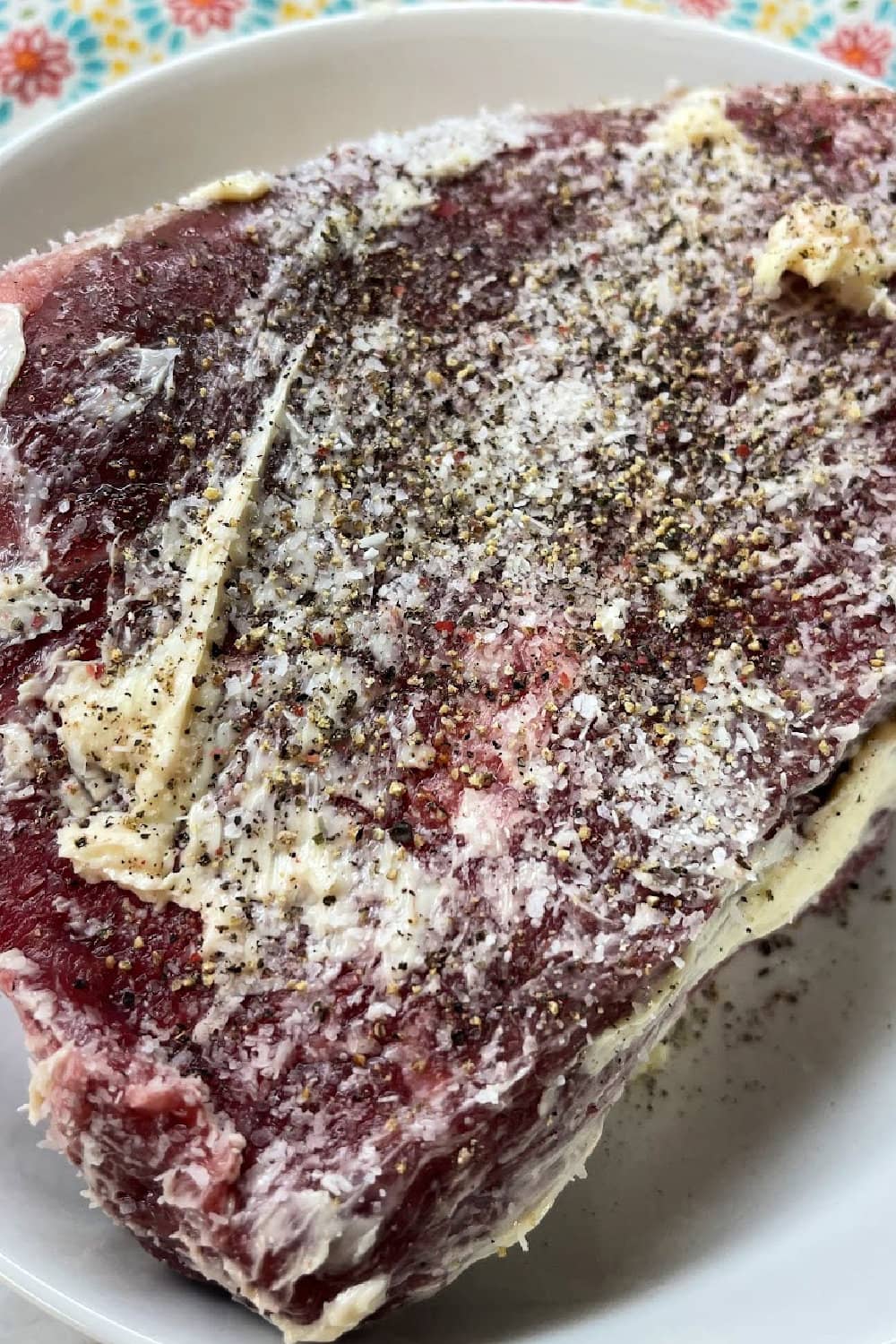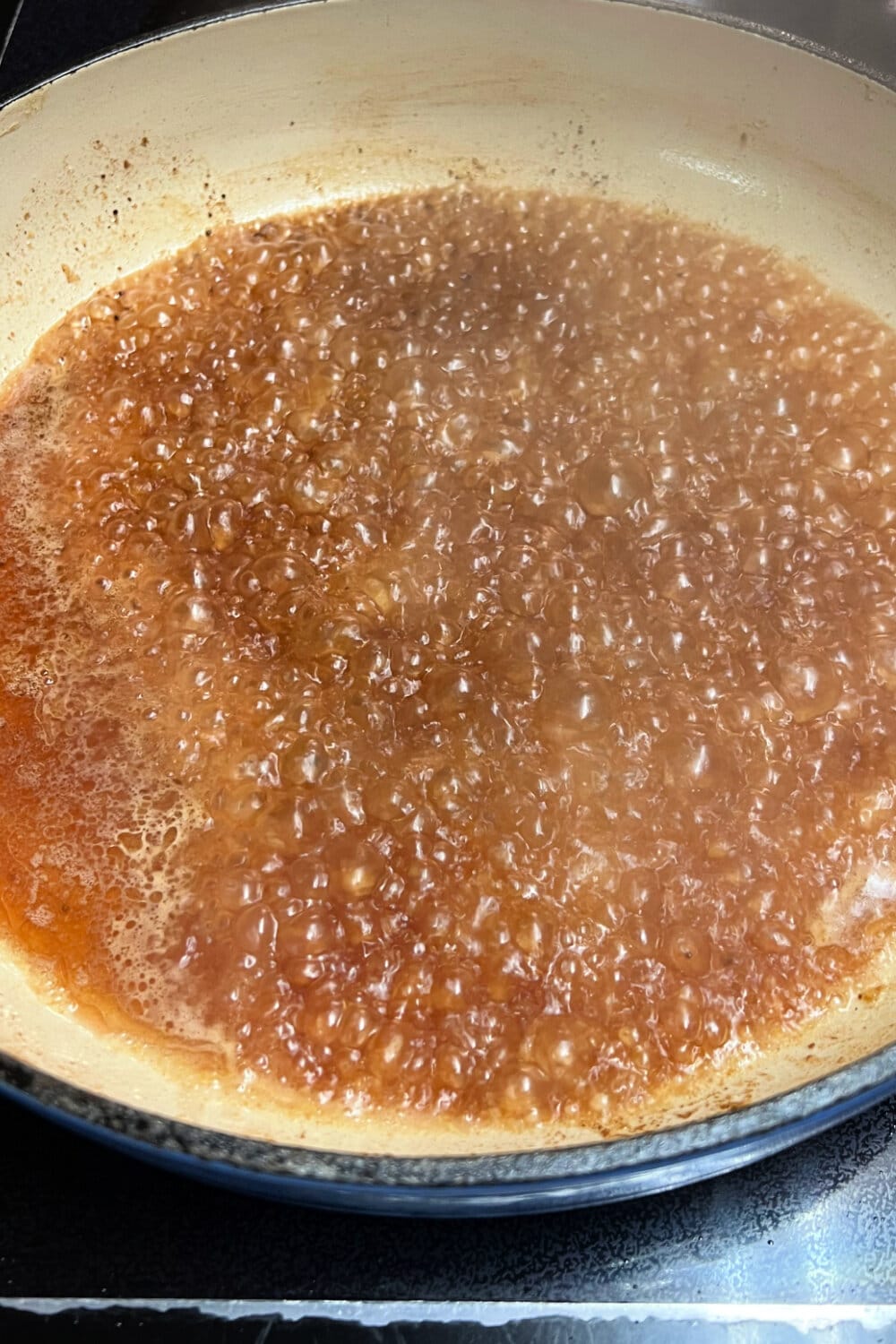Sliced Rump Roast
Tender, juicy Sliced Rump Roast baked in your oven makes the perfect Sunday dinner or a great weeknight meal.
This is the absolute best way to cook rump roast!

Save this Recipe
Rump Roast Recipe
This rump roast is among the best values in the meat case at your local grocer or butcher.
Because there’s no bone, you can eat the entire piece of meat. This makes it a very economical choice for feeding your family.
Just as it sounds, this cut of beef comes from the back end of the cow, close to the tail.
This roast gets a lot of exercise on the cow. It is very flavorful but also a tough cut of beef that is very lean.
Cooking it to medium-rare and slicing the roast very thinly across the grain is the secret to this recipe.
Rump roast can be made in the oven, slow cooker, or Instant Pot, and most rump roast recipes call for cooking (braising) it in liquid to keep the meat moist.

Ingredients for Sliced Rump Roast Recipe
- Rump roast
- Butter: You can substitute olive oil or vegetable oil, if needed, but butter provides superior browning and flavor.
- Beef broth and red wine: If you don’t want to use wine, you can omit it, then double the amount of broth for the recipe.
- Garlic and onion: You can use either a white or a yellow onion, whatever is on hand. If you don’t have fresh garlic cloves, you can substitute garlic powder or granulated garlic.
- Fresh rosemary or thyme: If you don’t have that on hand, you can substitute dried thyme leaves and dried rosemary leaves.
Recipe tips for rump roast
- Allow the rump roast to have some time to rest on the counter (out of refrigeration). This removes a lot of the chill from the protein fibers, so it can cook much more evenly.
- You do not have to do the extra step of browning the roast in this recipe. It is very worthwhile since browning adds so much extra flavor to the meat.
- Slicing the roast across the grain into thin slices. This is the key to serving rump roast that is tender and easy to experience.
How to cook rump roast
About 2 hours before you plan to cook the roast, remove it from refrigeration. Unpackage it to allow the chill to remove itself from the meat.
This allows the protein fibers to relax and the meat juices/fats to redistribute themselves throughout the roast.

During this wait time, season rub one tablespoon of butter over the exterior of the roast, then season well with salt and pepper on all sides.

When you’re ready to cook the roast, preheat the oven to 375 degrees F.
Melt the remaining two tablespoons of butter over medium-high heat in an oven-safe Dutch oven or a large, deep skillet.
When the butter is hot, sear all sides of the roast until well browned.

Remove the roast to a platter, then remove any remaining fats in the pan.
Still using medium-high heat, deglaze the pan by adding the beef broth and red wine, scraping up any browned bits that remain on the bottom.

Place the roast back into the pan, then surround it with the garlic cloves, onion slices, rosemary, and thyme sprigs.

If you use a digital meat thermometer, insert the probe into the center of the roast at the thickest part; set the temperature on the meat thermometer to 130 degrees F.

Cook the roast, covered, on the center oven rack for 30 minutes. Then reduce the oven temperature to 225 degrees F.
Continuing to cook the roast until it reaches 130 degrees at the center for medium-rare.
This will generally take 12-15 minutes for each lb. of beef, depending on how chilled the roast is when you begin the cooking process.
Remove the roast from the pan to a cutting board. Tent the roast loosely with foil, letting the roast rest for 30 minutes to allow the meat fibers to relax.
Slice the roast across the grain into very thin slices to serve. Drizzle with some of the warm pan juices.

Rump roast vs. chuck roast
Rump roast comes from the back end of the cow. Chuck roast comes from the front end of the cow, off the shoulder, to be exact.
Rump roast is very lean, with lots of connective tissue throughout the meat.
Chuck roast, on the other hand, has lots of fat marbling all throughout the roast.
Rump roast is a bit more tricky to cook than chuck roast due to how lean it is.
Chuck roast is one of the easiest roasts to cook because it has a good amount of fat to keep it nicely moist during the cooking process.
How to make tender rump roast
If you want rump roast served medium-rare, be sure to slice the roast across the grain (not with the grain) into very thin slices.
This shortens the protein fibers of the meat, making it much easier to chew.
Recipes for rump roast beef typically call for a braising liquid of wine and beef broth for cooking roast beef that is moist and tender when eaten.
Shredded rump roast is also delicious and delivers a hearty and satisfying roast experience.
What is rump roast
Rump roasts are a triangular cut of beef from the upper part of a cow’s rear end near the loin.
Rump roast is a very lean roast with lots of connective tissue, so there’s no fat trimming to do before cooking it.
Is rump roast tender
Rump roast recipe in the oven can be deliciously tender as long as it’s cooked properly.
This recipe is for thinly sliced rump roast served medium rare.
You can also cook the rump roast low and slow until very fork-tender and turns into shredded rump roast.
How long to cook 3 lb. rump roast in oven
Using this recipe for thin-sliced medium rare rump roast, it takes about 2 hours and 15 minutes to cook a 3-lb. rump roast.
If you want a more tender version of rump roast that is shredded, you’ll need to cook it low and slow for a longer period of time.
Another name for rump roast
Different regions of the country have other names for standard cuts of beef.
Rump roast here in the Midwest is also bottom round roast, round tip roast, and bottom round oven roast in other regions.
Rump roast with a bone is typically called a standing rump roast, no matter where you live.
What to do with a rump roast
Leftover sliced rump roast make great sandwiches and subs.
We love to use leftover rump roast to make French Dip sandwiches. Or, you could substitute leftover rump roast to make sliders.
We often add leftover rump roast slices to Caesar salad for a quick weeknight meal or it finely chopped in pinwheels.
Can you use a rump roast for pot roast?
Yes, rump roast is a type of roast, whereas pot roast is a method of cooking a roast.
Most often, chuck roast is used to make pot roast, but you can certainly use a rump roast for making a pot roast just as well.
The best way to cook rump roast is low and slow – it’s delicious!
Does rump roast shred?
Rump roast shreds easily if it is cooked low and slow in a braising liquid until very fork-tender.
How to slice a rump roast
When slicing medium rare rump roast as in this recipe, you’ll want to slice across the grain (not with the grain).
This will shorten the fibers of the meat, making it easier to chew.
Also, we suggest slicing the roast into thin slices to make it easy to cut and chew.
What is the best cooking method
I like to braise rump roast Dutch oven when cooking it which means cooking it in a flavorful liquid, such as broth, wine, or beer.
Does rump roast get tender the longer you cook it?
If you are cooking rump roast low and slow in a braising liquid, it will get more tender the longer it is cooked.
Why is my rump roast still tough?
If you cook a rump roast too quickly without a braising liquid, it will be dry and tough.
Rump roast is naturally tough due to all the connective tissue it has and because it comes from an area of the cow that gets a lot of use.
Should you brown before slow cooking?
I believe in browning a rump roast no matter how you are cooking it!
Browning roast before cooking it adds loads of extra flavor and is always a worthwhile step.

More favorite meat recipes
Instant Pot Eye of Round Roast shares all the cooking secrets to make roast beef that’s tender, juicy, and medium-rare.
Garlic Butter Eye of Round Roast is a flavor-packed beef roast recipe with a simple herbed butter crust perfect for casual weekend gatherings or a holiday meal.
Beef Top Round Roast in the oven makes the most tender slices of perfectly cooked and seasoned, juicy beef roast that is budget-friendly and delicious.
This Country Style Asian BBQ Ribs recipe will teach you to make fall-apart tender boneless ribs, right in your oven.

Sliced Rump Roast
Save this Recipe
Ingredients
- 3 pounds rump roast
- 1 tablespoon salted butter
- 1 teaspoon kosher salt
- 1 teaspoon black pepper
- 2 tablespoons salted butter, divided use
- 1 cup beef broth
- 1 cup dry red wine
- 3 cloves garlic
- 1 large yellow onion sliced
- 2 medium sprigs fresh rosemary or thyme (or use a little of each one)
Instructions
- About 2 hours before you plan to cook the roast, remove it from refrigeration and unpackage it to allow the chill to remove itself from the meat so the protein fibers can begin to relax. During this wait time, rub one tablespoon of the butter all over the exterior of the roast, then season well on all sides with kosher salt and black pepper.3 pounds rump roast, 1 tablespoon salted butter, 1 teaspoon kosher salt, 1 teaspoon black pepper
- When you're ready to cook the roast, preheat the oven to 375 degrees F.
- Melt the remaining two tablespoons of butter over medium-high heat in an oven-safe Dutch oven or a large, deep skillet. When the butter is nicely hot, sear all sides of the roast until well browned.2 tablespoons salted butter, divided use
- Remove the roast to a platter, then remove any fats that remain in the pan.
- Still using medium-high heat, deglaze the pan by adding the beef broth and red wine, scraping up any browned bits that remain on the bottom.1 cup beef broth, 1 cup dry red wine
- Place the roast back into the pan, then surround it with the garlic cloves, onion slices, rosemary and/or thyme sprigs. **If you are using a digital meat thermometer, insert the probe into the center of the roast at the thickest part; set the temperature on the meat thermometer for 130 degrees F.3 cloves garlic, 1 large yellow onion, 2 medium sprigs fresh rosemary or thyme (or use a little of each one)
- Cook the roast, covered, on the center oven rack for 30 minutes, then reduce the oven temperature to 225 degrees F., continuing to cook the roast until it reaches 130 degrees at the center for medium-rare. **This will generally take 12-15 minutes for each lb. of beef.
- Remove the roast from the pan to a cutting board. Tent the roast loosely with foil, letting the roast rest for 30 minutes to allow the meat fibers to relax.
- Slice the roast across the grain into very thin slices to serve. drizzled with some of the warm pan juices.
